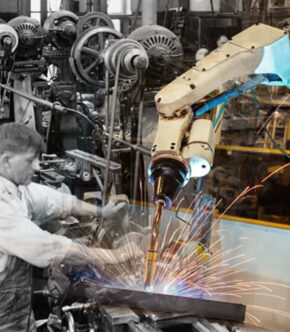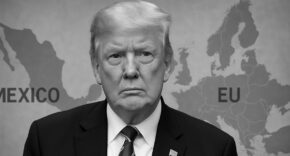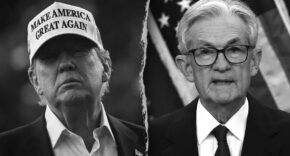A National Revival Begins
Across factory floors, venture capital offices, and Capitol Hill, a quiet revolution is gaining momentum. The goal is simple but bold: to make America a global industrial power once again. After decades of offshoring and economic hollowing, reindustrialization has become more than a policy idea. It is now a national mission, and former President Donald Trump is emerging as its central figure. His second-term agenda places industry, national security, and innovation at the heart of America’s future. Optimists call this moment a once-in-a-century opportunity to restore not only economic strength, but American pride.
Trump’s April 2 “Liberation Day” tariffs were more than just trade policy—they marked the opening move in a strategy to bring jobs, factories, and vital technologies back home. As Dr. Al Naqvi of the American Institute of AI put it, “The next industrial age is underway. America must decide whether it will lead that future or be shaped by those who do.”
The Six Foundations of Reindustrialization
To truly rebuild America’s industrial base, six essential pillars must be strengthened. These are not abstract theories—they are practical strategies already showing signs of progress.
1. Strategic Sector Prioritization
America can no longer afford to outsource its most vital capabilities. From semiconductors to batteries to rare-earth magnets, these technologies form the backbone of both economic power and national defense.
In the words of national security analyst Nadia Schadlow, “The United States must focus on the manufacturing trifecta for critical components: chips, batteries, and rare earth magnets.” Without them, fighter jets cannot fly, soldiers cannot communicate, and electric cars cannot move. As she warns, “The entire life cycle of batteries is controlled by China,” creating a dangerous dependency.
Progress: Trump’s first term saw a focus on strategic industries, but his second-term agenda is even more ambitious. Companies like TSMC and Micron are building major chip plants in the U.S., with help from the CHIPS Act. Meanwhile, Trump-backed legislation aims to ramp up rare-earth mining and battery production. His team sees these industries not just as economic targets, but as matters of national survival.
2. Technological Innovation and Entrepreneurship
The new industrial revolution will not be powered by steam or steel, but by artificial intelligence, robotics, and advanced materials. Manufacturing must be smarter, faster, and more flexible.
Kevin Czinger, founder of Divergent 3D, describes this transformation as “a Manhattan Project for manufacturing.” His company’s AI-powered systems can retool a factory in hours, producing car parts in the morning and aerospace components at night. Startups like Atomic Industries use AI to cut the cost of building tools by 90 percent, making previously unthinkable manufacturing ideas now possible.
Progress: Trump’s tariffs are giving American innovators a home-field advantage. “Tariffs can play a catalytic role,” says Dr. Naqvi. “They offer the U.S. economy a vital breathing space.” Venture capital firms like Tamarack Global and Founders Fund are pouring money into these frontier companies, many of which see Trump’s second term as a launchpad.
3. Workforce Development and Education Reform
Factories need workers. But the workers of tomorrow must be trained in robotics, AI systems, and advanced machinery. The U.S. faces a staggering shortfall: up to 1.9 million manufacturing jobs may go unfilled by 2034.
The root of the problem is cultural and educational. A former factory worker recalled being told in school, “If we didn’t jump through the proper hoops, we’d all end up working in some God-forsaken factory somewhere.” That attitude, common for decades, drove a generation away from skilled trades.
Progress: Trump’s plan includes reviving apprenticeship tax credits and pushing federal partnerships with trade schools and technical colleges. The National Council for the American Worker, launched in his first term, will be revived and expanded. Private programs like Lockheed Martin’s vocational scholarships and Electric Boat’s high school pipelines are already thriving. “We need to educate and train our industrial workforce,” says economist Skyler Adleta, “or we risk watching industrial policy and investment flounder.”
4. Capital Investment and Private Sector Alignment
American capital markets are the deepest in the world, yet manufacturing often struggles to attract funding. Wall Street has traditionally preferred software companies with high margins and fast returns. But that is starting to change.
Prince Ghosh, a manufacturing investor, explains: “Private market investors are going to miss out on huge venture-scale returns if they don’t accept that massive addressable markets make it okay to invest in non-90% margin businesses.” The key is creating the right incentives to unlock private dollars for physical infrastructure.
Progress: Trump’s team is pushing creative tools like federal offtake agreements, where the government guarantees purchases from strategic factories. This gives investors confidence to fund plants, mines, and ports. The Department of Energy recently used this approach to support Solugen, a startup making eco-friendly chemicals. The Office of Strategic Capital at the Pentagon is also pioneering new ways to attract private capital to defense manufacturing.
5. Energy Infrastructure and Grid Resilience
Tomorrow’s factories need power, and lots of it. AI data centers, chip plants, and automated systems are energy-hungry. But America’s aging grid is already strained.
Some projects, like Amazon’s nuclear-powered data center plans, have been blocked by regulators worried about reliability. This, critics say, is a self-inflicted wound. As Commissioner Mark Christie warned in dissent, “Reliable electricity is the lifeblood of America’s leadership in AI.”
Progress: Trump’s energy policy emphasizes reliability, not just renewables. He is expected to fast-track pipelines, nuclear power plants, and natural gas exports. His team is also exploring converting shuttered coal plants into nuclear sites. “It’s not about denying climate change,” one advisor said. “It’s about powering a 21st-century economy without blackouts.”
6. Smart Trade and Tariff Strategy
Globalization hollowed out America’s industrial base. Trump’s team sees trade as the lever to reverse that trend. His tariffs are designed not to isolate America, but to give it room to rebuild.
Robert Lighthizer, Trump’s former trade representative, put it plainly: “The accumulation of years and years of trade deficits led to the United States trading ownership of its productive assets and economic future for short-term consumption.” New tariffs will target countries that subsidize key industries, such as China’s battery and solar sectors.
Progress: Trump’s April 2 tariffs place a 30% duty on EU and Mexican imports in strategic categories. Critics say prices may rise, but Trump’s advisors argue that the long-term gain in domestic capacity and national security outweighs short-term costs. Trade negotiations will be based on reciprocity, and countries refusing to play fair will face higher barriers.
How Trump Became the Catalyst
Donald Trump’s political instincts have always aligned with working-class America. In his second term, he appears more focused on turning that instinct into policy. His first administration rolled back over 100 environmental rules and produced net regulatory savings of nearly $1 billion. But critics said he lacked a long-term vision. Now, that vision is forming—one that blends tariffs, energy, workforce training, and national security into a single strategy.
At the April Reindustrialize Summit in Detroit, Kevin Czinger of Divergent said, “This isn’t just policy. It’s a movement.” Trump’s actions have become a lightning rod for a broad industrial revival, bringing together entrepreneurs, venture capitalists, factory owners, and engineers.
Supporters believe America is on the cusp of a new golden age. With the right leadership, they argue, the U.S. can leapfrog the world using AI, automation, and flexible production.
“The way we win,” said Austin Bishop of Tamarack Global, “is by leveraging tech policy and our peerless capital markets to increase the efficiency of U.S. manufacturing.”
In the wake of Trump’s tariffs, companies like Vela Bikes and Simple Modern have moved production back to U.S. soil. Apprenticeships in Ohio are up 69% since 2014, and venture capital is flowing into factory tech once considered too slow or unglamorous.
Critics warn that Trump’s plan could backfire. They argue that tariffs raise consumer prices and risk retaliation. Some fear the government may pick winners and losers, repeating the failures of past industrial policies.
Others question whether the cultural shift toward blue-collar work will be fast enough. “I left the factory,” said one tradesman, “because there was no path up, and the work was mind-numbing. It wasn’t the job I wanted for life.”
Still, even many skeptics admit the industrial decline has gone too far—and that doing nothing is not an option.
The stakes are high. Trump’s strategy is not just about economics. It’s about restoring national strength and sovereignty. “This is a full-spectrum national transformation initiative,” says Dr. Naqvi. “It is not only about competitiveness—it is about resilience and security.”
With the right combination of leadership, policy, and investment, the next 20 years could see a rebirth of American industrial greatness. Trump’s vision has already forced both parties to take reindustrialization seriously.
The embers are glowing. The factories are stirring. The will to rebuild is rising. America’s second industrial age may already be underway.











